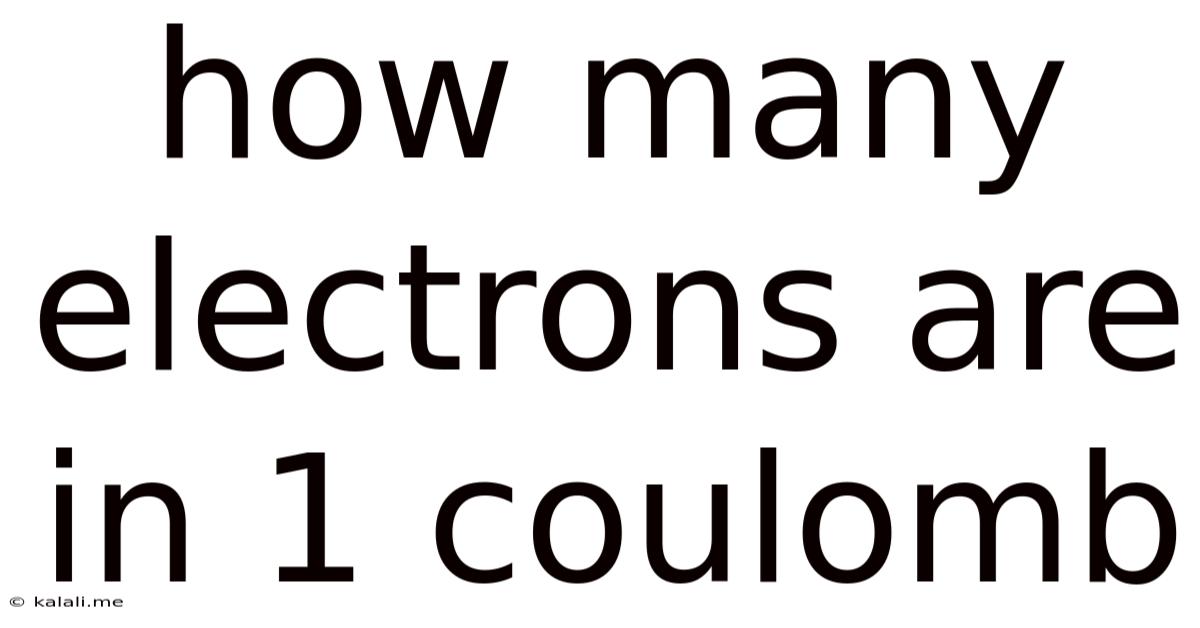How Many Electrons Are In 1 Coulomb
Kalali
Jun 11, 2025 · 2 min read

Table of Contents
How Many Electrons are in 1 Coulomb?
This article will delve into the fundamental relationship between Coulombs and electrons, answering the question: how many electrons constitute one Coulomb of charge? Understanding this is crucial for grasping basic electromagnetism and electrical engineering principles. We'll explore the concept, provide the calculation, and discuss its implications.
One Coulomb (C) is the Standard International (SI) unit of electric charge. It represents a significant amount of charge, and it's defined by the amount of charge transported by a constant current of one ampere (A) in one second (s). This seemingly simple definition hides a fundamental truth about the quantized nature of electric charge. Electric charge isn't continuous; instead, it's carried in discrete packets by elementary particles like electrons and protons.
Understanding Elementary Charge
The elementary charge (e) is the fundamental unit of electric charge, carried by a single proton or (the negative of) a single electron. Its value is approximately 1.602 x 10⁻¹⁹ Coulombs. This incredibly small number highlights the vast number of electrons needed to make up even a small Coulomb of charge.
Calculating the Number of Electrons in 1 Coulomb
To determine how many electrons are in one Coulomb, we simply divide the total charge (1 Coulomb) by the charge of a single electron:
Number of electrons = Total charge / Elementary charge
Number of electrons = 1 C / (1.602 x 10⁻¹⁹ C/electron)
Number of electrons ≈ 6.24 x 10¹⁸ electrons
Therefore, there are approximately 6.24 x 10¹⁸ electrons in one Coulomb of charge. This is a truly enormous number, illustrating the microscopic scale at which individual electrons operate.
Implications and Applications
This calculation has significant implications across various fields:
-
Electronics: Understanding the number of electrons involved in current flow is essential for designing and analyzing electronic circuits, from simple resistors to complex integrated circuits. The movement of these vast numbers of electrons creates the electrical currents we utilize daily.
-
Electromagnetism: The concept of Coulomb's law, which describes the electrostatic force between charged particles, directly relies on understanding the quantity of charge involved. The massive number of electrons in even a small charge emphasizes the strength of electromagnetic forces.
-
Physics: This calculation reinforces the quantized nature of electric charge, a fundamental concept in quantum physics. The discrete nature of charge has far-reaching consequences for our understanding of the universe at a fundamental level.
Conclusion
The number of electrons in one Coulomb – approximately 6.24 x 10¹⁸ – is a staggering figure that underscores the vast quantity of charge involved in even seemingly small electrical phenomena. This understanding is fundamental to a variety of scientific and engineering disciplines and provides a crucial link between the macroscopic world of electric current and the microscopic world of individual charged particles. It highlights the power of a single unit of charge and the importance of understanding the fundamental building blocks of electricity.
Latest Posts
Latest Posts
-
How Many Feet Is In 40 Yards
Jul 01, 2025
-
Least Common Denominator Of 9 And 7
Jul 01, 2025
-
How Many Feet In A Mile And A Half
Jul 01, 2025
-
11am To 9pm Is How Many Hours
Jul 01, 2025
-
How Many Feet Are In 50 Yards
Jul 01, 2025
Related Post
Thank you for visiting our website which covers about How Many Electrons Are In 1 Coulomb . We hope the information provided has been useful to you. Feel free to contact us if you have any questions or need further assistance. See you next time and don't miss to bookmark.